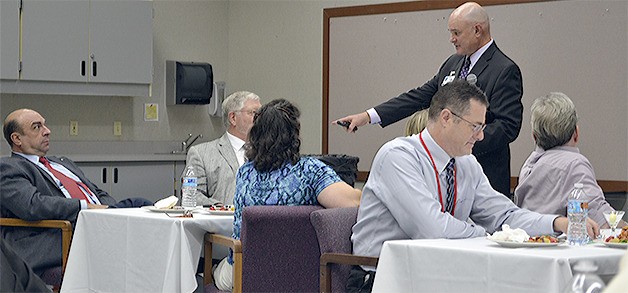MARYSVILLE – The three pillars of society are crumbling, and it is up to schools to step up, a national education expert told Marysville school and city leaders Sept. 8.
“Schools need to pull a lot of the slack,” John Draper said. “We used to say: ‘It’s not our job.’ Well, it is now.”
He was referring to how families and the church have deteriorated in society, so it is up to schools to help raise children.
Draper, of the National Schools Public Relations Association, said schools used to say they would teach children, but not raise them. But not anymore.
“You almost have to be like family,” he said. “If you don’t help raise them they’re not going to make it. It’s a lot cheaper to educate than to incarcerate.”
In the Marysville School District, of the 11,000 students, more than 5,000 receive free or reduced lunch.
“They are the best meals they get, sometimes the only meals they get,” Draper said.
Draper talked to teachers in the morning and city leaders at lunchtime about “The Inside Scoop on Public Schools.”
Draper pointed out that for about half a century schools have done a terrible job at public relations. Instead of working with the media to point out successes, it has let itself become a scapegoat.
He said it started when the country was criticized for losing the space race to Russia. The schools were blamed, but then did not get credit when the United States was first to the moon.
Similar bashing has taken place over the years, but the resulting theme is that nothing is taught until it is learned. Teachers can no longer say: “I taught it. It’s not my fault if they didn’t learn it,” Draper said.
He said in most communities people feel their schools are good, but others are bad. That’s a myth, Draper said. About 95 percent of schools are good, but people only think of the 5 percent that are bad.
As for the Achievement Gap, he said race isn’t the biggest cause, it’s actually poverty.
“You can’t teach all the same way,” he said. “It takes different instruction time, too.”
Such division between the haves and the have nots is a precursor to a revolution, he warned.
Draper attacked a number of other myths during his talk.
•He said graduation rates are at 81 percent – the highest ever. Draper talked about a poor district that has a 97 percent graduation rate. He said when a student is ready to drop out, they do whatever they can to keep them in school. They offer night classes, smaller workloads, whatever it takes. “They throw out the book, and say, ‘How can we help?'”
•Charter schools aren’t any better. School lasts two hours longer each day so their scores often are a little higher.
•75 percent of the public likes the idea of paying more for better teacher performance. But he said that would require higher taxes to pay bonuses. That also would create divisions within the teaching ranks. He said teachers should be rewarded but in other ways.
•Scholastic Aptitude Test scores are down. He said that’s been the case for 30 years because in the beginning only the best students took SATs. Now, many students are taking it, so while the average score has gone down the subgroups of minorities, etc., taking the test are improving.
•International test scores are terrible. That has always been true, Draper said. Other countries only allow their best students to take that test, while all U.S. students take it. There is also a different culture in the U.S. Here, seniors “enjoy” their last year, while in other countries they have to pass a graduation test to go to college.
Draper said the U.S. is right in the middle in international scores, which is where it should be. He said many Asian countries that finish high have students who lack creativity.
“It’s healthy being not to skinny or not too fat,” he said as a comparison.
He ended by saying schools make a difference.
“We save lives every day,” he said. “Miracles happen every day in public schools.”



